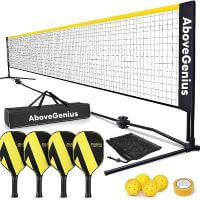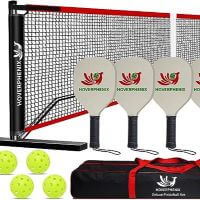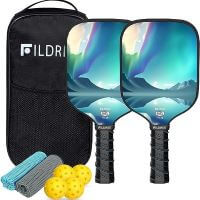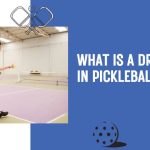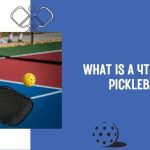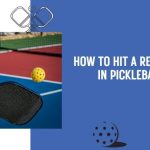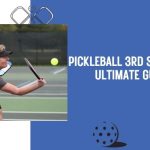Pickleball lob shots have been around since the beginning of pickleball, but they’ve become increasingly popular in recent years. Pickleball players should add the lob to their arsenal of strategies.
But it’s also important to know how to defend yourself against it. The pickleball lob shot can become your secret weapon with a little practice and know-how.
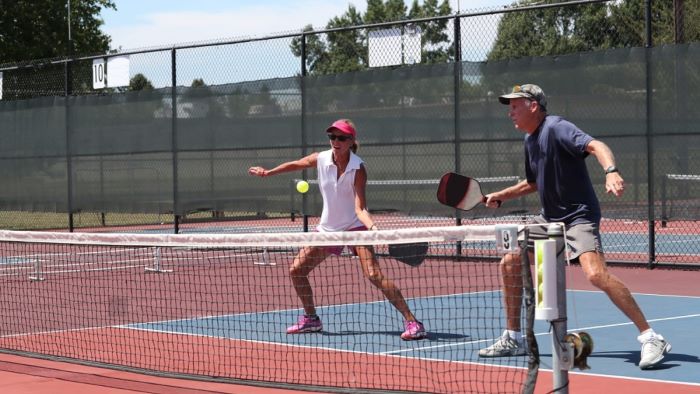
You Might Also Like:
What Is Lob Shot?
In pickleball, lob shots are high-lofted shots that aim at sending the ball high and deep over the opponent so that it ends up in the back of the court. Pickleball players can benefit greatly from this shot. Players can use this shot when their opponent stands at the non-volley zone line, close to the net.
A pickleball shot that moves your opponent away from the non-volley line also called the kitchen, gives you extra time to set up for your next shot while putting your opponent on the defensive.
USA Pickleball defines a lob as a lofted shot that sends the ball high overhead and deep.
Offensive Lob Shot
The trajectory of an offensive pickleball lob is flatter than that of a defensive lob. Designed to curve just above your opponent’s reach, it will land behind them.
Using an offensive lob is the best option when your opponent is at the edge of NVZ (“The Kitchen”) because they will need to scramble backwards to return the shot.
How to Hit Offensive Lob?
A successful offensive lob requires both technique and strategy. An out-and-up motion and a slight angle of the paddle face are the most basic steps in the game.
Lift the ball upwards while lifting your knees in a balanced position with the paddle under the ball. Your weight should transfer towards your intended target. A reasonable amount of distance will separate you from the contact point. You will have less control if you have to stretch to reach the ball.
Pickleball lob shots should not be “telegraphed” from a strategic standpoint. Surprises work best when it comes to lobbing shots. Players who are preparing for lob shots often change their stance. To hit a drop or a dink shot, keep your knees bent, your body compressed, and paddle in front of you.
When you strike the ball from below, you use your wrist, elbow, and shoulder in one smooth motion to rotate the paddle so that it grips and rotates the ball. You’ll feel natural in no time with a little practice!
When Is an Offensive Lob a Smart Shot?
Especially when your opponent leans in anticipating a dink, the offensive lob works best. In the Non-Volley Zone, hitting an offensive lob is easier than hitting a drop shot.
Getting the ball over your opponent’s head and out of their reach will be more difficult the farther you are from the NVZ line. Your opponent has more time to react to your lob if the ball is in the air for a long period. Finally, take into account the elements. Sunlight will make it more difficult for your opponent to see and return the lob.
Based on its direction and strength, the wind may make your lob easier or harder. If you’re hitting into the wind rather than with it, it’s easier to control your offensive lob, but you must hit it hard enough to clear your opponent’s head. You are more likely to lose your lob when the wind is blowing from behind you. A lob should consider both factors.
When to Avoid Offensive Lob Shots?
Being aware of your opponent’s location is crucial. If they’re deep in the back of the court, don’t lob them the ball. Rather than lob over their heads, you will hit the ball back at them.
Many pickleball players try a lob on their third shot when the double bounce rule applies (instead of a third shot drop). You will often get caught by your opponents at the kitchen line if you attempt a lob shot, as they are usually in prime position.
Lobbers with long arms tend to be taller and difficult to beat. As a result, it becomes even more crucial to curve the ball higher to get it over them. The shorter the ball, the easier it will be for them to reach it, and the more likely it is that they will smash it overhead.
As a final tip, try not to hit an offensive lob when you are in a poor position to do so. Keeping your body low and your paddle in front of the ball will help you get your paddle under it easily when you make contact.
Defensive Lob Shot
Imagine yourself scrambling to return the ball to your opponent as he takes control of the point. Staying in the rally could be easiest and safest with a high lob. You can reposition for the next volley with this defensive shot.
Defensive lobs have a higher arc, which keeps the ball in the air for a long time. Also, this gives your opponent time to decide what shot to take, which might be a fast overhead.
How to Hit Defensive Lob?
Defensive lobs differ from offensive lobs in two primary ways. A paddle’s angle at contact and the direction of its follow-through are essential factors.
The open face of your paddle should point more toward the sky when performing a defensive lob. As with the offensive lob, your follow-through should rise vertically rather than outward.
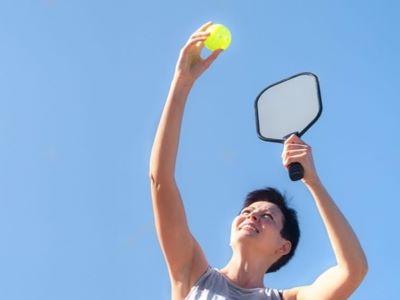
Avoid flicking the wrist like you would with an offensive lob. Put your pickleball paddle beneath the ball and keep your body low. Place your knees and weight into the shot as you guide and lift it upwards. You will have much greater control this way.
When Is a Defensive Lob a Smart Shot?
By using the defensive pickleball lob, you can buy yourself time. By forcing your opponents back to their baseline when they are at the NVZ line, a defensive lob can help you reposition yourself and get back on the offensive.
Remember that if you use a defensive lob, your opponent may have enough time and space to respond offensively. By aiming for higher arcs, you will have less time for your opponents to return aggressively. Also, make shots with spin or angled shots to make it harder for your opponent’s paddle to reach them.
In pickleball, avoid taking too much risk when choosing when and where you want to use a defensive lob shot. If done incorrectly, it could lead to easy points for your opponents as a result of poor placement or insufficient power. Thus, timing is key here, as well as knowing where on the court to place defensive lob shots, whether it’s lower or higher than usual, depending on what works best against particular opponents.
When to Avoid Defensive Lob Shots?
There is a tendency for the defensive lob to be a last-resort shot. The kick is usually hit on the run or from a vulnerable position, and it might be the only way to stay in the rally. Offensive shots are subject to the same considerations. Avoid lobs to players deep in the court who are likely to return them aggressively.
Backing up means focusing on the ball, getting your paddle in position, and moving your feet back to position your body in the right position, and that’s where you get into trouble. As you back up, your legs are more likely to cross and get tangled. Due to your unstable balance, you may trip yourself and fall.
How to Return a Lob in Pickleball?
One of the critical skills in pickleball is the ability to return a lob shot. A successful lob return is essential to beat your opponent in a pickleball match.
To successfully return a lob shot, first position yourself to face the net diagonally across from where your opponent hit the ball. It will give you enough time to get into position before the ball reaches you and provide an angle for hitting it back toward your opponent’s court.
When returning a lob, it’s essential to aim for deep in your opponent’s court so that they cannot reach it with their paddle or racquet; this will force them out of position and give you an advantage during the point play.
When hitting the ball back over, use an open-face paddle grip on both sides rather than simply using one side or another; this helps generate more power behind each strike and will make it harder for your adversary to recover from their shot quickly enough for them not be forced out of position again on their next turn at bat.
Additionally, try adding spin onto your shots; this gives you more control over where each hit goes and can make it difficult for opponents who aren’t expecting such shots coming towards them (especially when done unexpectedly).
Finally, practice regularly! The better-prepared players are, the more likely they'll be able successfully to execute those tricky shots during an actual game!
FAQs
The lob shot is one of the most important pickleball skills. Learning how to hit lob shots and defend against them is essential.
Offensively, lobs are best when your opponent is near the NVZ line and isn’t expecting them. When you need time to “reset” the point and get into a better position defensively, you should lob.
In pickleball, you can defend against lobs by anticipating when they will be hit, crushing them with an overhead shot, or running toward the baseline to return them.
As the paddle faces contact the ball, lift your wrist, elbow, and shoulder together to rotate the paddle face. When this happens, friction will create a forward rotation of the ball between it and the paddle.
Wrap Up
If you want to improve and be competitive in pickleball, you’ll need to be able to execute effective lobs at all levels.
Once you understand the techniques and strategies behind lobs, hitting them and responding to them isn’t too hard. You will become a master of the lob with a little practice on the court now that you know how and when to hit it and how to respond to it.

I am a professional physiotherapist and the author of the BallSportsPro. I worked with athletes of all levels, from amateur to professional, and i helped them overcome injuries and improve their performance. I am a certified Pickleball instructor and has been playing the sport for over 10 years.

